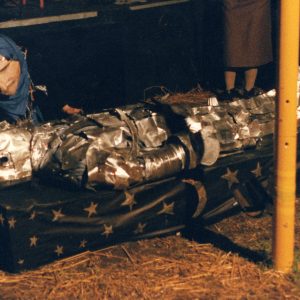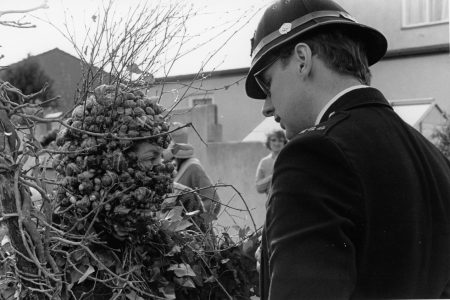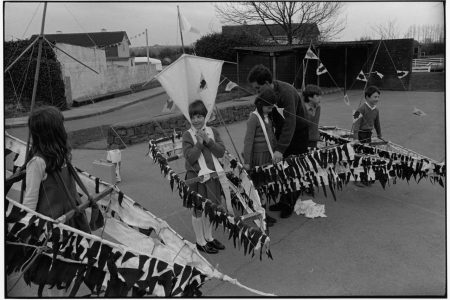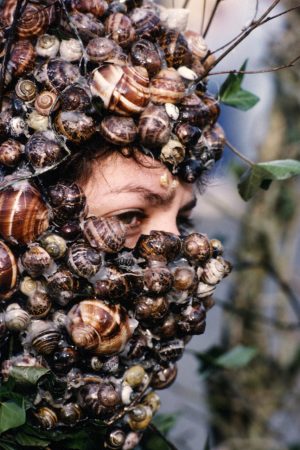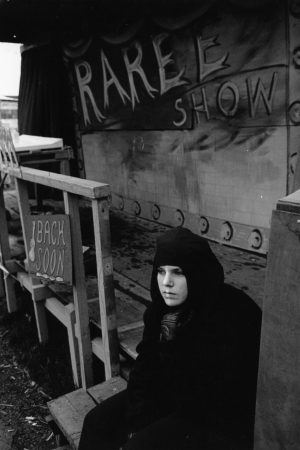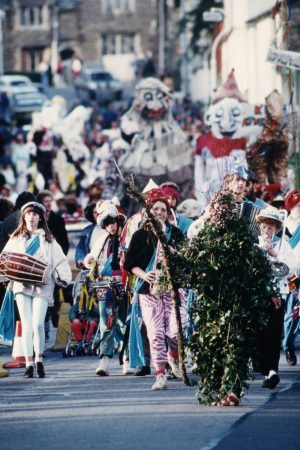Midsummer Cabaret 1985

In Cleveland the Arts Officer was Joanna Moreland, who became a friend and later went on to work for Common Ground. Joanna commissioned Horse + Bamboo to create a large community event; we called it Midsummer Cabaret (photos above). The idea was for a large tented and decorated space on Wolviston village green. The company had previously toured to the village, pitching our marquee there, and we hit it off well with the local community. Midsummer Cabaret involved a special performance by Horse + Bamboo alongside satellite shows done by school and community groups. We also led workshops and training sessions to develop these smaller shows. The whole of the community was involved, either performing, running side-shows, or simply coming along as members of an audience. It was a great thing to do, and a lot of fun.
The 12 Curlicues of Pilton
The Beaford Centre, now Beaford Arts, was Europe’s largest rural arts centre and was set up by Dartington Hall Trust. At the beginning of 1986 the company was asked by Beaford’s Rick Bond to consider a residency based at Pilton, on the outskirts of Barnstaple. The idea was to work towards a large scale event at Easter 1987, far bigger than the Wolviston event, that would also celebrate the 21st anniversary of the Beaford Centre itself. A small group of us would live in the village from February, gradually being joined by others until 17 Horse + Bamboo artists in all were working with the village community to create events in late April.
I met Rick and we visited Pilton, met with people and explored the village. In September a group from Horse + Bamboo paid a second visit; then in December 1986 I went to Pilton with Sue Goodwin from Rakuworks, and together we mounted an exhibition about the work of both companies. We also continued our research into the village and its history, and began to make initial contacts with interested local people and groups. Pilton is a fascinating place, with an unusual number of features; very much the quintessential English village, with a medieval church with leper squints, a Green Man, and even its own priory. It also had a history of ‘pageants’ involving the community; a Lady Well; a standing stone and no end of quirky corners and unusual traditions. I began to feel that a celebration of all of these things should be at the heart of the project, and I came up with the idea of The 12 Curlicues of Pilton. A curlicue being the knot of hair once favoured by sailors, like a small curly pigtail. (The 4 photographs below, and central photograph in the bottom row are courtesy of James Ravillious):
On the 9 February 1987 I was joined in Pilton by Steph Bunn and Robin Morley, and the three of us followed up on the initial contacts, sourced materials and established 33 community groups who were going to work with us. Mary Plumb soon joined to direct and lead the music. By the 16 March there were 11 members of the company living and working in the village, and shortly afterwards Sue and Laura from Rakuworks joined us to work with community groups to make a permanent mosaic village sign. 18 groups met regularly to create the ‘curlicues’ (sideshows) or to help with creating parades and processions. Other groups worked with Mary to create a village band and worked on a specially commissioned piece of music.
There were three processions, one each day over Easter – a Good Friday Lantern Procession; an Easter Sunday Bell Procession, and an Easter Monday Carnival Procession. The local park, sitting in the meander of the River Yeo, was commandeered for a fairground, with every stall and event hand-made and overseen by Bernard Tindall, with help from community. There was also a grand final event, the Raising of the Green Man. All of this was communicated to the villagers in the ‘Curlicue Times’ news-sheet that I produced with Robin. In all there were three editions, with every household in the village receiving one. In the first edition local people chose which of the many features of their village should make up the twelve ‘curlicues’.
Roughly 500 people were directly involved in the events. There were many local stalls in the park, as well as a bandstand, a maze, a menagerie made by Steph with local students, a cafe, mystery passages, a story-telling centre, a cinema, a shadow show and a central performance area. The whole event was recorded by the village in an illustrated book ‘The Curlicue Scrapbook’, which celebrated The 12 Curlicues with photographs, reproductions from my notebooks and the ‘Curlicue Times’, along with comments and memories from many of the villagers.


